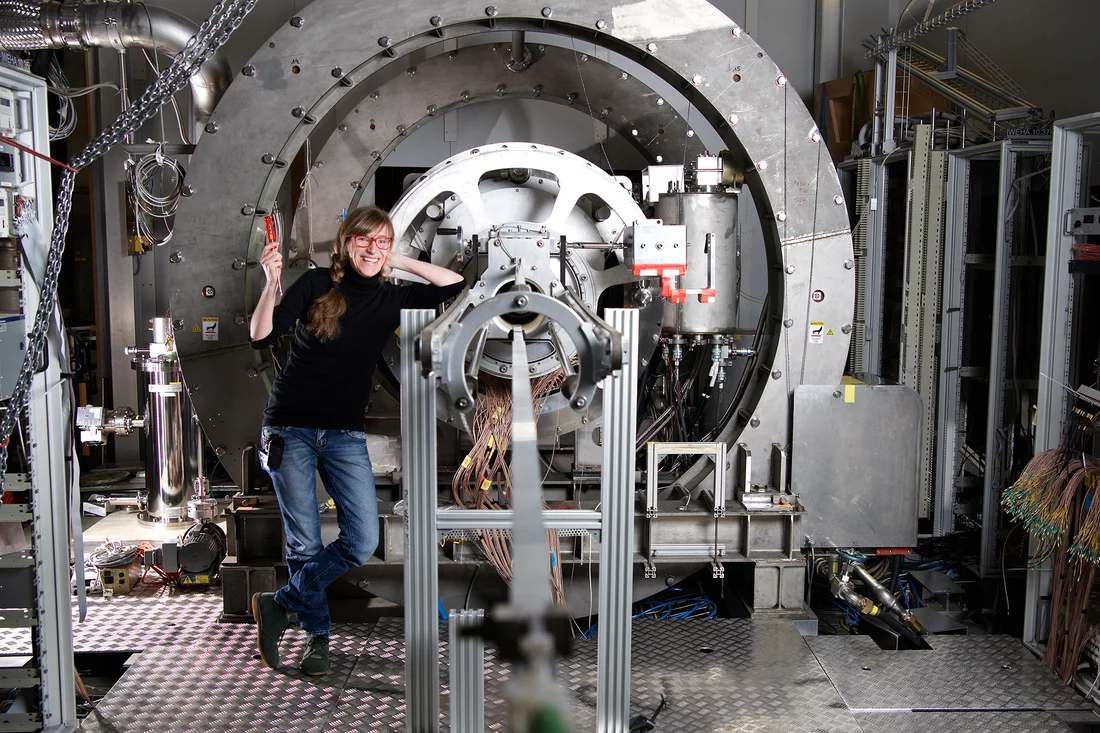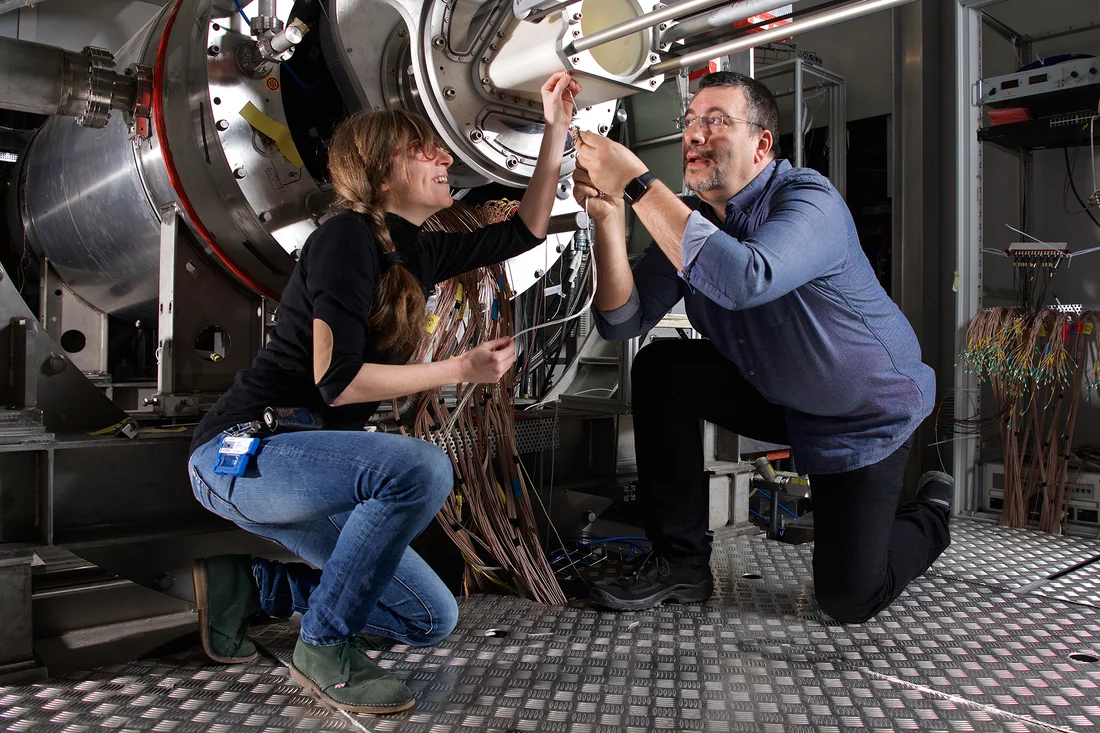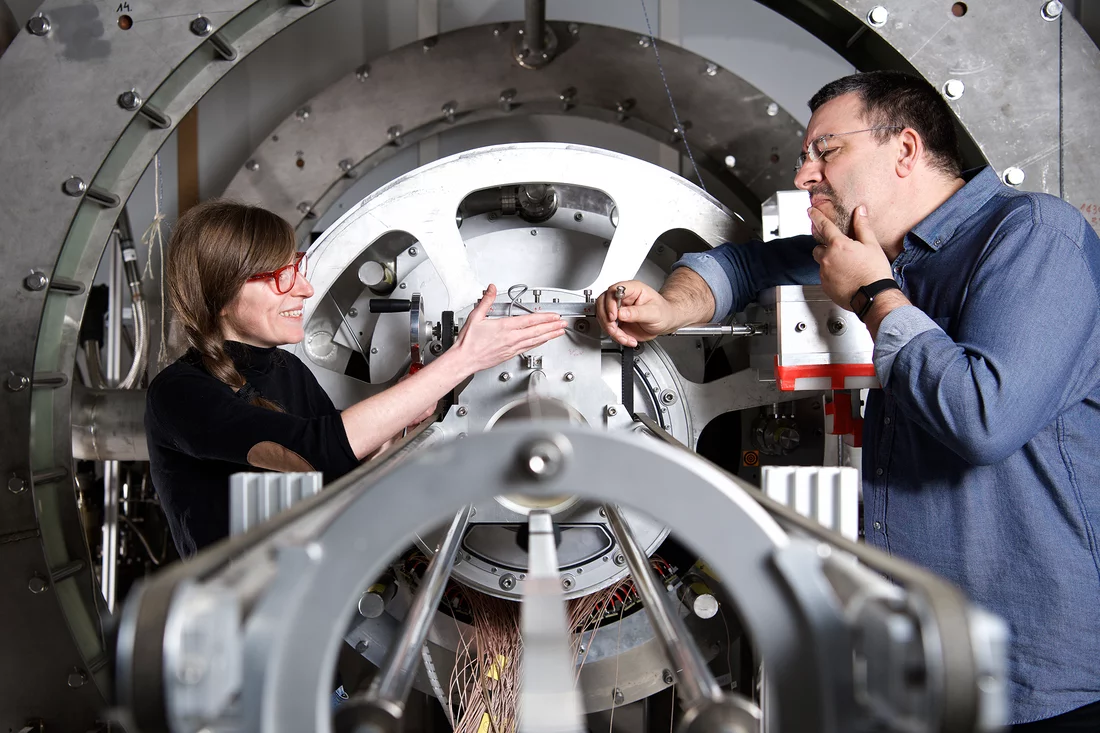Measuring the rarity of a particle decay
Modern physics has developed a great number of theoretical approaches with which the world of elementary particles can be described. Now it's up to experiments to sort out which theories hold up against reality. One of these is the so-called MEG experiment at the Paul Scherrer Institute PSI. In a collaboration with researchers from Italy, Japan, Russia and USA, PSI physicists are searching for a particular, yet never-to-date observed decay of elementary particles known as muons. More precisely, they are quantifying how high the improbability of this decay is. According to their latest number, at most one out of 2.4 trillion muon decays will fit the MEG pattern. That makes such a decay around five hundred thousand times more improbable than hitting all six numbers in the Swiss lottery. For this highly precise measurement, the researchers have observed an extremely high number of muon decays – which was only possible at the PSI, site of the world's most powerful muon beam facility. Thus the PSI research group repeatedly breaks its own world record for measuring the MEG probability. The researchers are now presenting their latest result at the international conference Les Rencontres de Physique de la Vallée d'Aoste in La Tuile, Italy.
They are exotic elementary particles that also are very short-lived: Practically as soon as they come into existence, muons decay into other, more stable particles. In doing so, however, they can take different decay paths, meaning either this or that group of particles results from the decay. One of these decay paths, a very special one, has in fact never been observed but is of great interest to physicists: the decay of a muon into one electron and one light particle. This is also known by the abbreviated name MEG decay
, for muon-electron-gamma, in which gamma stands for the light particle.
It has long been clear that a MEG decay is extremely rare. Exactly how rare is what researchers at the Paul Scherrer Institute want to quantify with the MEG experiment. In the process they anticipate the discovery of new physics
– and with it a doorway into previously unexplained phenomena in the universe. On the basis of the researchers' latest measurements, which again have brought to light not one single MEG decay, they now can say: The probability for this decay is smaller than one in 2.4 trillion, or in other words around five hundred thousand times less likely than hitting all six numbers in the Swiss lottery.
The MEG experiment can test theories about the universe
This experimentally determined number is a relevant parameter for theoretical physicists who develop mathematical models with which to describe no less than our entire universe. According to some of these theories – among them the conventional Standard Model of particle physics – the MEG decay hardly ever occurs and therefore is impossible to observe. The Standard Model is a comprehensive concept that explains very much of what humanity has been able to observe so far – but unfortunately, not everything. Among other things, the Standard Model has nothing to say about the existence of the so-called dark matter and dark energy: those mysterious things now thought to make up, together, around 95 percent of the universe.
That is why scientists around the world are searching for new physics. This would be represented by a theory that includes the predictions of the Standard Model but also goes beyond it – thereby describing our universe more comprehensively. One promising group of theories is Susy, short for supersymmetry. Many of the theoretical models from the Susy family predict a probability for the MEG decay that is high enough that this event should be observable, sooner or later, at the PSI. With each successive, increasingly precise measurement in which the decay is not found, another set of alternative theories can be eliminated.
Five years of continuous measurement at the world's most powerful muon source
The researchers arrived at the newly quantified improbability of the MEG decay through the analysis of data they gathered, nearly continuously, between 2009 and 2013. Not only was the long measurement time necessary to obtain the newly available results – the realization of the experiment at the PSI was also decisive. This is the site of the world's most powerful muon facility, where around 30 million muon decays per second can be observed. It is only thanks to this high throughput that the researchers were able to measure a total of 2.4 trillion muons and their decays. The decisive MEG decay was not among them – thus setting the new upper limit for its probability.
No discovery – and yet a meaningful result
Even though the MEG decay was not found, the participating researchers view their experiment as a success. Precisely because we have not, up to this point, seen this decay, we are able to shift the theoretical line behind which the new physics must be sought,
explains Angela Papa, a particle physicist at the PSI and co-author of the new study. And yet if we should one day observe a MEG decay, that would be a strong indication towards new physics.
So far, that does not mean that an entire theoretical approach, such as supersymmetry for example, must be thrown out, rather only individual models within such families of theories.
In the future, the PSI researchers will refine and continue to pursue their MEG experiment, and with it, the search for the MEG decay. Whether they one day observe this decay or not – the measurement results will in any case contribute substantially to our knowledge regarding the fundamental structures of matter.
Text: Paul Scherrer Institute/Laura Hennemann
About PSI
The Paul Scherrer Institute PSI develops, builds and operates large, complex research facilities and makes them available to the national and international research community. The institute's own key research priorities are in the fields of matter and materials, energy and environment and human health. PSI is committed to the training of future generations. Therefore about one quarter of our staff are post-docs, post-graduates or apprentices. Altogether PSI employs 1900 people, thus being the largest research institute in Switzerland. The annual budget amounts to approximately CHF 380 million. PSI is part of the ETH Domain, with the other members being the two Swiss Federal Institutes of Technology, ETH Zurich and EPFL Lausanne, as well as Eawag (Swiss Federal Institute of Aquatic Science and Technology), Empa (Swiss Federal Laboratories for Materials Science and Technology) and WSL (Swiss Federal Institute for Forest, Snow and Landscape Research).
(Last updated in February 2016)
Additional information
Knowledge from nothing –Erkenntnis aus dem Nichts, in German only
The quest for an elusive white crow of particle physics
Measuring the simultaneity
Contact
Dr. Angela Papa, Laboratory for Particle Physics, Paul Scherrer InstituteTelephone: +41 56 310 55 39, e-mail: angela.papa@psi.ch [English, Italian]
Dr. Stefan Ritt, Laboratory for Particle Physics, Paul Scherrer Institute
Telephone: +41 56 310 37 28, e-mail: stefan.ritt@psi.ch [German, English]
Original Publication
Search for the lepton flavour violating decay μ+→e+γ with the full dataset of the MEG experimentMEG Collaboration
The European Physical Journal C 3. August 2016 (online)
DOI: 10.1140/epjc/s10052-016-4271-x



